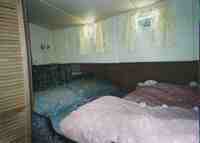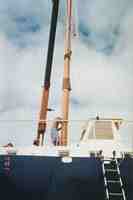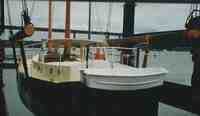FITTING OUT YEARS 2000 TO 2001

|
Fitting out begins
So the
question now was where to begin. The last three years were spent on steel work
and now I had to re program my mind to think about the various sub systems that
I needed to install before launch. First thing was to fix all the batons onto
the frames, bulkheads and floor beams. These in turn would take the plywood
covering and this in turn would take the furniture fixings. I worked out that I
needed 500m of 50mm by 25mm wood for the batons. This arrived in due course and
I started the long drilling, painting and bolt tightening operation that was required
to fit all of the baton wood. I had seriously underestimated the amount of wood
required and in the end it took 1600m of wood to complete the battening.
That’s a mile of wood just for that. Next I painted the bilge area with
three coats of bilge paint. The next job was to fit the 25mm marine plywood
which would be the side and bottom of the diesel and water tank mounts. These
were fastened in place with stainless steel screws and nuts and bolts.
Meanwhile the tanks had arrived and they were mounted in place. Then the
plumbing was started. All plastic fittings where used including plastic tube
for cold and hot water. Once the plumbing was competed and tested the diesel
tanks were connected and diesel fuel hose was run into the engine room. Next
followed the bilge pumps and their respective hoses. After this was completed a
gulper toilette pump was fitted and a number of 3 way valves were connected in
such a way that the pump could discharge either from the black water holding
tank or from the grey water holding tank through a 2” seacock. The cabin
sole was fixed to the beams and cut outs were added to enable access to the
various hatches. We move on board
Then as
planned we moved on board. Ann and I, Mitzi and Monty our dogs. We worked from
dawn to dusk every day for the next three months. Whilst working one day down
below Ann carried Mitzi down the ladder so the dog could run around the yard
for a few hours. Ann came back up the ladder and continued her varnishing job.
The next thing I knew was that Mitzi was jumping down the companionway steps. I
asked Ann if she had carried Mitzi back up the ladder, she said no. So we
repeated the procedure carrying the dog down the ladder we returned to the
cockpit and watched. In front of our eyes Mitzi climbed up that 14’
ladder one rung at a time waggling her tail all the way up. We could not
believe our eyes we had never seen a dog do that. This was how Mitzi got onto
the boat every time she was in the yard and wanted to rejoin us on deck. After
a few days we never gave it another thought. Then one day we heard shouting
from the yard. A woman was standing there mouth wide open unable to utter a
word. Hm, Ahm, uh, your dog just climbed that ladder she said finally regaining
her speech. Yes Ann said she does that. The woman was Rowan Warner fellow yacht
owners. Grampus their 37’ Colvin Watson motor sailor was also in the
yard. Rowan and her husband Roly were in the middle of a refit. She told us
that as we had a dog that could climb ladders we must be decent people and
promptly invited us to dinner that evening. Steering Problems
After
all this was finished I fitted the hydraulic steering and the rudder. Ann and I
then commenced bleeding the system. Ann had to turn the steering wheel one way
while I filled the reservoir. Ok no problem we thought I filled then Ann
turned. A big bang and we had hydraulic oil all over our nicely varnished
interior wood. Ann was not a happy bunny. A phone call was made to Lancing
Marine, who had also supplied the steering system, they said the pump was
broken, it happens sometimes. Not to me it doesn’t I was furious. They
could not have tested it prior to supply. Lancing Marine calmed me down and
advised that they would send me a new pump and that it would arrive within
three weeks. Three weeks I wanted on within the next three days launch day was
the 31 July and it was the 21 July. I would deduct £150 per day that they were
over the three days from out final payment. That got things rolling. The pump
arrived on day 5 so they were not going to receive £300. So be it. Next I
connected the hydraulic ram to the pump and connected the ram head to the
tiller arm. This is the bit that fits onto the top of the rudder shaft and is
used as a lever for the ram to push or pull against and thus move the rudder.
Well it did not work. There was about a 10 degree travel of the rudder in each
direction I was baffled. I checked the fitting instructions again and again. No
fault there. So another phone call to Lancing marine. Oh, they said must be a
to short tiller arm. They could get the correct one and deliver it to us.
Delivery date two months. I stayed calm for about two seconds and then
exploded. You can imagine what I said or maybe you can’t but I can not
repeat it here. Lancing Marine gave me a number for another supplier. They advised
that I send all the dimensions to them they also told Lancing to provide them
with the layout drawings Lancing had made at the design stage. Again to cut a
long story short Lancing had made the wrong calculations, they had not taken
the size of the rudder into effect or the size of it. Well we needed a
hydraulic ram 6 times the size of the one Lancing marine had delivered. This of
course meant a bigger pump. Luckily the hydraulic piping was OK. The Launch
Ann’s daughter, my sister, my
mother, Roly and Rowan, Wendy & Franc and other friends arrived for the
launch early the next day. For ten months we had heard the roar of the travel
hoist going backward and forward collecting boats for launch and today was our
turn. The final cup of tea was had on land and at 11 am we walked behind our
yacht towards the launch area. Ann held a bottle of champagne I held on to the
dogs. I was a little worried. Thoughts like will she float right? Will she
float at all? I kept telling everyone that should she sink then we will own a
submarine. No one was listening though all eyes were on the travel hoist. It
finally settled over the water. We tied a line around Ann’s waist and she
leant over and smashed the champagne over a cleat. Her words were, “I
name this ship Ruffles Spray and may god bless all those that sail upon
her”. My eyes were watering as the hoist went down. All eyes were on the
waterline as Ruffles Spray touched the water. Down she went and the water rose
up until she floated. The slings were removed and I went below to check the
hull and bilge. No leaks. No water coming in from anywhere. So far so good. I
started the engine and checked the systems. Roly and Rowan tied on the fenders
and Ann released the lines. I motored ahead and slowly steered Ruffles Spray
into a berth in Nayland marina. I was sweating a lot but managed it without any
damage. --
|



